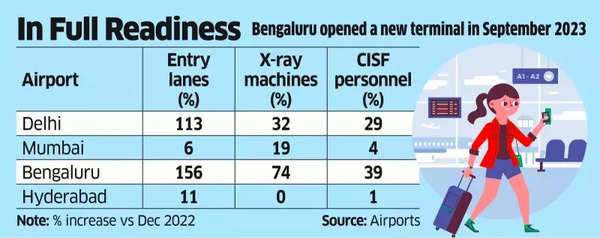According to an ET report, the Ministry of Civil Aviation has said that these airports have nearly doubled their capacity to handle passengers during peak hours. This winter season has witnessed a significant increase in air travel, with daily passenger numbers consistently surpassing pre-Covid levels.
Airports ramp up infrastructure
The decision to enhance infrastructure came after the government mandated that any new flight additions must consider the airport’s capacity to handle passengers at security checkpoints. This directive was issued by the Bureau of Civil Aviation Security (BCAS) following last winter’s chaos at Delhi airport, where passengers faced long wait times for entry and security checks.
According to the BCAS, each X-ray machine can process a maximum of 180 domestic passengers per hour and 160 international passengers per hour. International travelers typically carry more luggage, resulting in a lower processing capacity for machines on the international side.
Civil Aviation Minister Jyotiraditya Scindia spoke of the improvements, stating that the the number of departure gates, passengers’ check-in gates, and X-ray machines have been increased. In some airports, we removed unnecessary spaces such as VIP lounges and retail areas to create more room, he said. These measures were taken to address space constraints faced by certain airports, he added.
Additionally, the Home Ministry has increased the number of Central Industrial Security Force (CISF) personnel and immigration staff at airports. For Delhi, the busiest airport in the country, CISF personnel have increased by 29% and immigration desks by 14%.
Scindia emphasized the importance of transparency in measuring airport capacity at various touchpoints. The BCAS has adopted international standards to measure processing time and establish parameters for departure entry gates, check-in kiosks, security checks, and immigration. These measures have effectively prevented congestion at airports, even with the surge in passenger traffic, he said.
